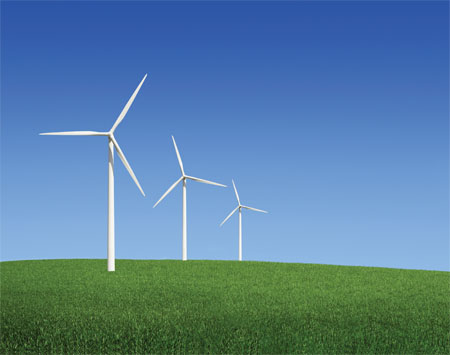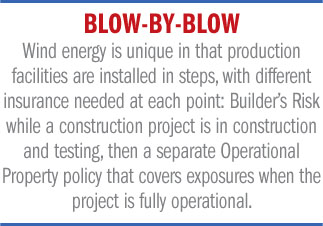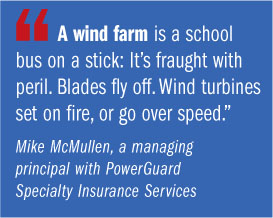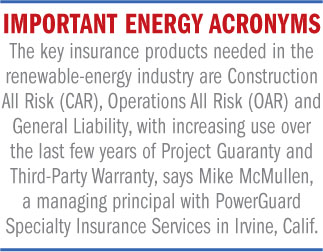 As both the price for andcontroversy around fossil fuels continue to grow, renewable-energyrisks are becoming an increasingly standard part of many insurers’portfolios—with wind and solar leading the green-power pack, farahead of biomass production and hydroelectricity.
As both the price for andcontroversy around fossil fuels continue to grow, renewable-energyrisks are becoming an increasingly standard part of many insurers’portfolios—with wind and solar leading the green-power pack, farahead of biomass production and hydroelectricity.
Wind, in fact, is one of the world’s fastest-growingenergy-related industries: 39,404 megawatts (MW) of wind power wasadded worldwide in 2010, and the total installed wind-generationcapacity globally grew by 25 percent from 2009 figures.
|But along with the new business opportunities for the insurancesector come some unique risks.
|“A wind farm is a school bus on a stick: It’s fraught withperil. Sometimes you get the claims before you get the premiums,”says Mike McMullen, a managing principal with Irvine, Calif.-basedPowerGuard Specialty Insurance Services, a managing general agentfor Edgewood Partners Insurance Center (EPIC), a regional insurancebroker based in San Mateo, Calif.
|RENEWABLE RISKS
|Wind energy is unique in that production facilities areinstalled in steps, with different insurance needed at each point:Builder’s Risk while a construction project is in construction andtesting, then a separate Operational Property policy that coversexposures when the project is fully operational.
| A wind farm with perhaps 100 windturbines will declare itself “operational” when a few of thoseturbines are put in place. Placement continues in phases; when thelast turbine placement is made, the wind farm is declared “fullyoperational.”
A wind farm with perhaps 100 windturbines will declare itself “operational” when a few of thoseturbines are put in place. Placement continues in phases; when thelast turbine placement is made, the wind farm is declared “fullyoperational.”
Chubb Commercial Insurance developed a hybrid policy that coversBuilder’s Risk while the project is being built, and it offers anendorsement that allows Operational coverage through theconstruction and completion. “Then we move the risk to 100 percentOperational,” says Camilo Posada, an assistant vice president andsenior underwriting specialist in Chicago for Chubb.
|Chubb provides the same type of package for solar power, but itis not used as often as in wind energy.
| LISTEN TO THE WIND (AND WATCH OUTFOR THE BLADES)
LISTEN TO THE WIND (AND WATCH OUTFOR THE BLADES)
PowerGuard specializes in the design and underwriting ofinsurance and risk-management solutions for wind, solar and otheralternative-energy companies.
|But some 90 percent of PowerGuard’s business is actually withsolar-energy firms; it provides about $6 billion in solar-panelwarranty-performance guarantees worldwide.
|“We saw this solar wave coming,” McMullen says. “Most of theinsurance companies around the globe are still not ready to writewhat is needed.”
|Only about 10 percent of its business is related to windfarms—and one reason why is the daunting nature of the risksinvolved.
|“We love to see people jumping into thewind-turbine market to get that extra capacity—and to write thosedeals that we don’t really want to write,” he adds.
| Each of a turbine’s three bladesis as long as a football field and is hollow to permit a technicianto walk inside for repairs. Winds may blow from zero mph to 200mph, and the amount of torque hitting the turbines combined withflying bits of sand and soil can wreak havoc.
Each of a turbine’s three bladesis as long as a football field and is hollow to permit a technicianto walk inside for repairs. Winds may blow from zero mph to 200mph, and the amount of torque hitting the turbines combined withflying bits of sand and soil can wreak havoc.
“Blades fly off. Wind turbines set on fire or go over speed,”McMullen says.
|On the Property side of the risk equation, turbines placed farfrom civilization can be targets for thieves, who strip them ofmiles of costly copper wire. Another big concern is serial defects,where similar construction problems occur in a large percentage ofa turbine shipment. “Historically, the Property insurer wouldsuspend coverage because it’s a warranty issue,” McMullennotes.
|Chubb’s Posada says one of the biggest liability exposures inwind energy is noise pollution. “It’s definitely an exposure thathas to be considered by an insurance company and a developer aswell. There is a potential for lawsuits; Canada has already seensome.”
| Tests are being done to measurethe effect that the constant “whooshing” noise of those giantblades turning at 100 mph has on the mental health of nearbyhomeowners.
Tests are being done to measurethe effect that the constant “whooshing” noise of those giantblades turning at 100 mph has on the mental health of nearbyhomeowners.
“There have already been a lot of studies in regard to the noiseand the effect of the noise on people from wind turbines, and stateregulations have become more explicit as to how far from homes andbuildings wind turbines can be placed,” says Russ Birch, seniorvice president for the RJ Ahmann Co., an insurance andrisk-management agency in Eden Prairie, Minn., that includes amongits renewable-energy clients biodiesel producers, ethanolproducers, wind-power facilities and solar-energy facilities.
|“Look at very large wind installations; you’d be amazed at howmuch noise they actually make,” Birch says. “It’ll be interestingto see what happens from an insurance standpoint and from alitigation standpoint. The question that will have to be asked is,‘Is this creating some form of bodily injury or property damage tothe surrounding neighbors?’ If so, you may have a legitimateliability issue.”
|Adding to the insurance factor is the increasing size of windturbines. Over the past 10 years they’ve gone from a turbine thatproduces some 750 kilowatt-hours of electricity to larger, 200 MWturbines, roughly three times the size of the originals.
|“What people often object to is sight pollution,” Birchadds.
|POPULAR DESPITE THE PERILS
|Despite all the potential drawbacks associated with wind farms,the technology continues to appeal.
|In New York State, for example, interest in wind power isdefinitely on the rise, according to Alan Wechsler, a spokesman forthe New York State Energy Research and Development Authority, whose“Behind-the-Meter” wind program received 65 applications in 2011from residents and businesses seeking incentives for installing awind turbine—the most requests received in one year.
|Wind installations already in use have seen an increase inbusiness, adds Wechsler. Meanwhile, the state’s large-scaleprojects that provide power directly to the power grid, such aswind farms, now have about 1,175 MW in operation, with another 311MW under construction. That’s a total of 10 wind farms currently inoperation, with six more under construction or in development.
|NYSERDA requires General Contractor’s Liability insurance forcontractors who participate in its statewide solar-electric,solar-thermal or wind-turbine programs.
|The market for solar electric in New York State also has grownsteadily, and the number of solar-electric installers statewidegrew by more than 60 percent between 2010 and 2011, addsWechsler.
Want to continue reading?
Become a Free PropertyCasualty360 Digital Reader
Your access to unlimited PropertyCasualty360 content isn’t changing.
Once you are an ALM digital member, you’ll receive:
- All PropertyCasualty360.com news coverage, best practices, and in-depth analysis.
- Educational webcasts, resources from industry leaders, and informative newsletters.
- Other award-winning websites including BenefitsPRO.com and ThinkAdvisor.com.
Already have an account? Sign In
© 2024 ALM Global, LLC, All Rights Reserved. Request academic re-use from www.copyright.com. All other uses, submit a request to [email protected]. For more information visit Asset & Logo Licensing.








